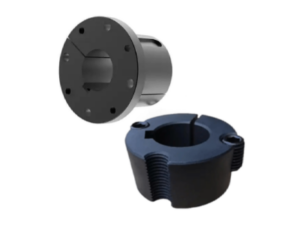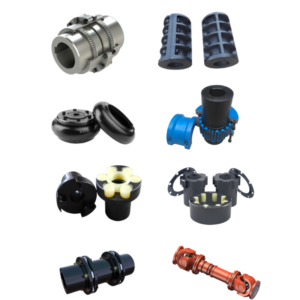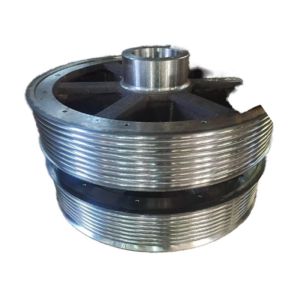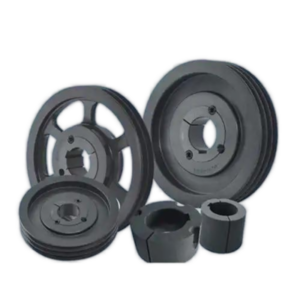In the realm of mechanical power transmission, the reliable connection between a shaft and a rotating component is paramount. While keyways and set screws have been traditional methods, the taper bushing (or tapered bushing) has emerged as a superior, versatile, and highly effective solution for mounting sprockets (for chain drives) and pulleys (for belt drives). This article explores the synergy of this combination, detailing its advantages, working principle, and key considerations.
What is a Taper Bushing?
A taper bushing is a consumable, interchangeable mounting device with a conical (tapered) exterior and a cylindrical bore. It typically consists of two main parts:
- The Bushing Itself: A split ring with a tapered outer surface and threaded holes.
- The Locking Plate: A flange with clearance holes that align with the threaded holes in the bushing.
When cap screws are tightened, the locking plate pulls the bushing into a matching tapered bore in the sprocket or pulley. This action causes the split bushing to compress uniformly onto the shaft, creating a immense frictional grip and a mechanical lock.
The Working Principle: A Wedge Action
The core principle is simple yet powerful wedge action. As the bushing is drawn into the pulley or sprocket, it undergoes radial compression. This simultaneously:
- Expands inward, gripping the shaft with tremendous, evenly distributed pressure.
- Contracts outward, locking securely into the tapered hub of the sprocket or pulley.
The result is a rigid, concentric, and backlash-free connection that transmits torque primarily through friction, with the key (if present) serving as an added safety measure.
Key Advantages of Using Taper Bushings with Sprockets and Pulleys
This combination offers significant benefits over direct-mounting methods:
- Simplified Installation and Removal: No need for heavy pressing, heating, or hammering. Components can be mounted and dismounted with simple hand tools, drastically reducing maintenance time and effort.
- Excellent Grip and High Torque Capacity: The uniform clamping force provides a secure hold, capable of transmitting very high torque loads without slippage, even on smooth shafts.
- Reduced Stock Inventory: A single size of taper bushing can fit a range of shaft diameters, and a single sprocket or pulley (with a tapered bore) can be used on different shaft sizes simply by changing the bushing. This standardizes components and simplifies procurement.
- Precise and Repeatable Positioning: Taper bushings allow for accurate axial positioning of the component on the shaft. Once loosened, they can be repositioned without damaging the shaft or the component.
- Minimized Shaft Damage: Since the connection is frictional and not reliant on a heavy press-fit, there is minimal risk of scoring, galling, or deforming the shaft. This preserves the integrity of the often more expensive shaft.
- Reduced Vibration and Misalignment Tolerance: The tight, uniform fit helps dampen vibrations and can accommodate minor shaft misalignments better than a rigid press-fit.
Application in Chain and Belt Drives
- With Sprockets (Chain Drives): In chain drives, sprockets are subjected to cyclical loads and “polygonal action” that can cause fatigue in the connection. A taper bushing ensures the sprocket remains firmly fixed, preventing fretting corrosion and wear at the shaft interface, which is critical for the long-term health of the drive system.
- With Pulleys (Belt Drives): Belt drives, especially V-belts and timing belts, impose radial and tangential forces on pulleys. The taper bushing maintains perfect concentricity, which is vital for smooth belt operation, preventing premature belt wear, and avoiding issues like belt whip or tracking problems.
Installation and Maintenance Best Practices
To ensure optimal performance and safety:
- Cleanliness: Ensure the shaft, bushing, and pulley/sprocket bore are clean, dry, and free of burrs or damage.
- Lubrication: Lightly lubricate the shaft and the outer tapered surface of the bushing to facilitate installation and removal. Never lubricate the inner surface that grips the shaft.
- Tightening Sequence: Tighten the cap screws gradually and in a cross pattern to ensure even pressure and prevent the bushing from cocking.
- Correct Torque: Always use a torque wrench and adhere to the manufacturer’s specified torque values for the cap screws. Under-tightening can cause slippage; over-tightening can damage the threads or the bushing.
- Re-torquing: After a short initial run-in period (e.g., 24 hours of operation), it is good practice to stop the system and re-torque the screws, as initial settlement may occur.
Conclusion
The integration of taper bushings with sprockets and pulleys represents a best-practice engineering solution in power transmission design. It marries exceptional holding power with unparalleled ease of maintenance. By providing a secure, concentric, and reusable connection, this system enhances reliability, reduces downtime, and extends the service life of both the driven components and the shafts, making it an indispensable choice for a wide range of industrial applications.





